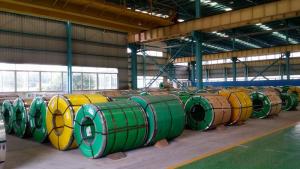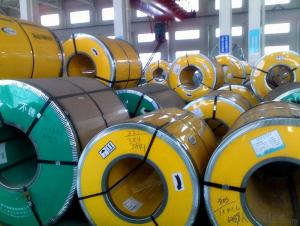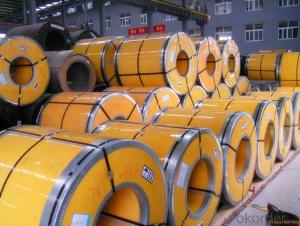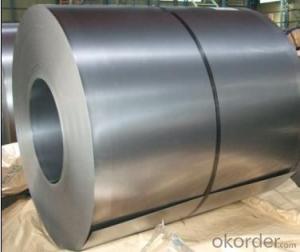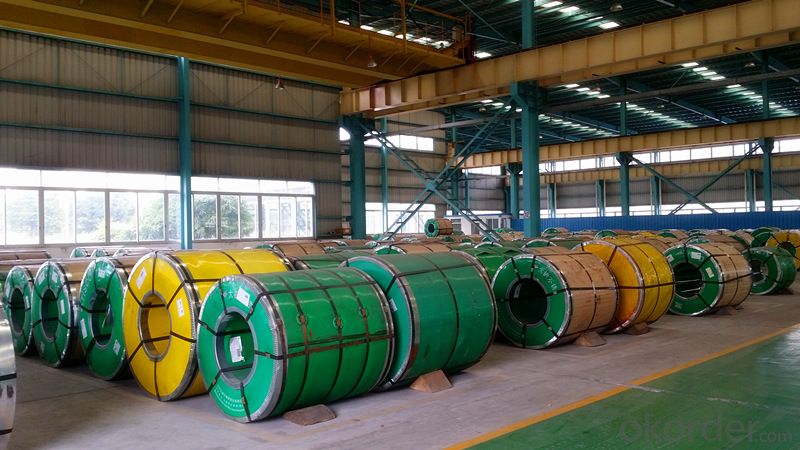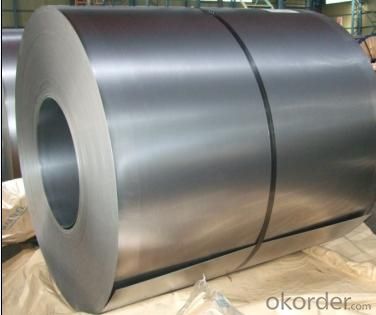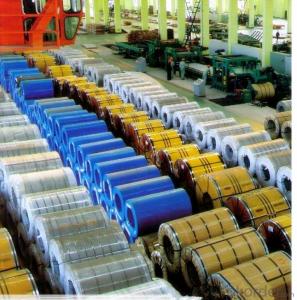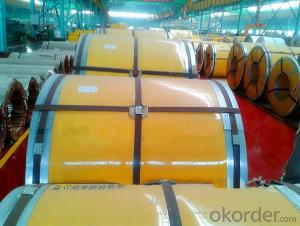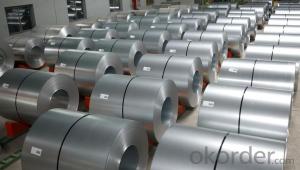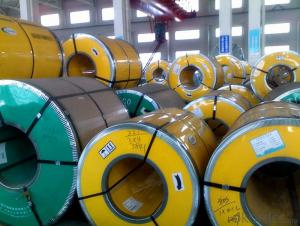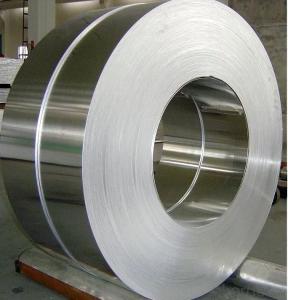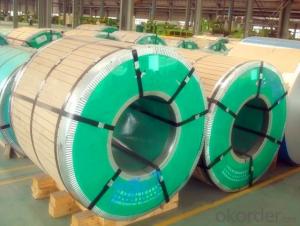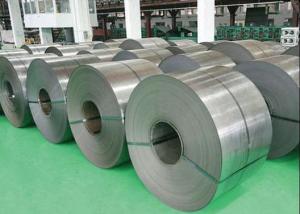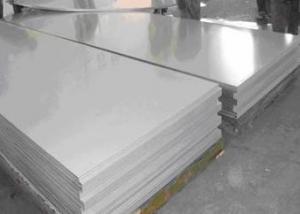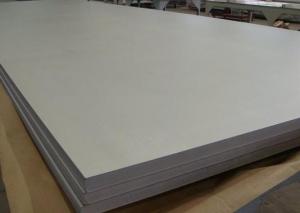Cold Rolled Stainless Steel Coil 304 Grade 2B Finish
- Loading Port:
- China Main Port
- Payment Terms:
- TT OR LC
- Min Order Qty:
- -
- Supply Capability:
- -
OKorder Service Pledge
OKorder Financial Service
You Might Also Like
Cold Rolled Stainless Steel Coil 304 Grade 2B Finish
Packaging Detail:standard export packing or as customer's requirements
Delivery Detail:7-15 days after the order
MOQ: 25mt
Standard: | AISI,ASTM,BS,DIN,GB,JIS | Grade: | 304 | Thickness: | 0.3-3.0mm |
Place of Origin: | China Mainland | Brand Name: | CNBM | Model Number: | 304 |
Type: | Steel Coil | Technique: | Cold Rolled | Surface Treatment: | 2B, BA |
Application: | Medical instruments, building, chemical food industry agriculture | Width: | 500-2000mm | Length: | Coil |
finish: | 2B | item: | 304 cold rolled stainless steel coil | density: | 7.93 |
Cold Rolled Stainless Steel Coil 304 Grade 2B Finish
Chemical composition: |
| ||||||
C | Si | Mn | Cr | Ni | S | P | |
≤0.07 | ≤1.0 | ≤2.0 | 18.0~20.0 | 8.0~11.0 | ≤0.03 | ≤0.035 | |
mechanical properties: |
| ||||||
Tensile strength σb (MPa) | Conditions yield strength 0.2 sigma (MPa) | Elongation δ5 (%) | Section shrinkage (%) | Hardness | |||
520 | 205 | 40 | 60 | ≤1 | |||
- Q: How do you measure the hardness of a stainless steel strip?
- Various methods can be utilized to measure the hardness of a stainless steel strip, with the Rockwell hardness test being the most commonly employed. This particular test involves the use of either a diamond cone or a hardened steel ball indenter to penetrate the surface of the strip under a specified load. Subsequently, the depth of the indentation is gauged, and a hardness value is determined according to the Rockwell scale. To execute the Rockwell hardness test, the stainless steel strip is securely positioned on a testing machine featuring a flat, smooth surface. The indenter is then brought into contact with the strip's surface, and an initial load is applied to establish the indenter's starting position. Following the establishment of the preliminary load, the final load is administered, causing the indenter to penetrate the surface to a specific depth. Once the load is eliminated, the resulting indentation is measured with the aid of either a microscope or an optical measuring device. The hardness value is determined by calculating the disparity between the depth of penetration under the final load and the depth of penetration under the preliminary load. Subsequently, this value is converted to a Rockwell hardness number through the use of a chart or a digital display on the testing machine. It should be noted that the Rockwell hardness test offers an assessment of the material's resistance to indentation, which indirectly correlates to its mechanical properties, including strength and toughness. Depending on the specific requirements and characteristics of the material, alternative methods like the Vickers or Brinell hardness tests can also be employed to measure the hardness of stainless steel strips.
- Q: What is the fracture toughness of stainless steel strips?
- The fracture toughness of stainless steel strips varies depending on the specific grade and composition of the stainless steel. Stainless steel is known for its high strength and toughness, making it resistant to fractures. However, the fracture toughness value can be influenced by factors such as the heat treatment, processing conditions, and any alloying elements present in the stainless steel. To determine the fracture toughness of a specific stainless steel strip, it is necessary to perform laboratory tests such as the Charpy or Izod impact tests or the J-integral test. These tests involve subjecting the material to controlled loading conditions and measuring the energy absorbed by the material before it fractures. The fracture toughness of stainless steel strips is typically characterized by the KIc value, which represents the critical stress intensity factor required for crack propagation. This value indicates the resistance of the material to fracture under a specific loading condition. Higher KIc values indicate greater fracture toughness. In general, stainless steel strips exhibit good fracture toughness due to their high strength and ductility. However, it is important to consider the specific grade and processing conditions of the stainless steel strip in order to accurately determine its fracture toughness.
- Q: What is the maximum temperature stainless steel strips can withstand?
- The maximum temperature that stainless steel strips can typically withstand depends on the specific grade and composition of the stainless steel. However, most stainless steel strips can withstand temperatures ranging from 800 to 1600 degrees Fahrenheit (427 to 871 degrees Celsius) without significant changes to their mechanical properties.
- Q: How do stainless steel strips resist pitting?
- Stainless steel strips resist pitting due to their unique composition and protective oxide layer. Stainless steel is made up of a combination of iron, chromium, and other elements. The presence of chromium in stainless steel strips is crucial as it helps create a passive oxide layer on the surface. This oxide layer acts as a barrier, protecting the underlying metal from corrosion and pitting. When stainless steel is exposed to oxygen, the chromium in the alloy reacts with the oxygen to form a thin, invisible film of chromium oxide on the surface. This film is self-repairing and prevents further corrosion from occurring. In case the oxide layer is damaged or scratched, it quickly reforms and continues to protect the stainless steel. Pitting occurs when localized areas of the stainless steel strip are depleted of chromium due to exposure to certain corrosive environments. These areas become more susceptible to corrosion, leading to the formation of small pits or holes on the surface. However, stainless steel strips have a high chromium content, typically around 10-30%, which provides excellent resistance to pitting. Additionally, stainless steel strips may also contain elements like molybdenum, which further enhances their resistance to pitting. Molybdenum increases the material's ability to withstand corrosive environments, making it even more durable. In summary, stainless steel strips resist pitting primarily due to the presence of chromium and the formation of a protective oxide layer. This combination ensures that the material remains resistant to corrosion, even in aggressive environments, making stainless steel strips a preferred choice in various industries.
- Q: Can stainless steel strips be used in automotive body panels?
- Indeed, automotive body panels can utilize stainless steel strips. With its versatility and durability, stainless steel proves to be an exceptional material that offers remarkable resistance against corrosion, substantial strength, and an elegant appearance. Due to these properties, stainless steel is suitable for various automotive applications, including body panels. These strips can be manipulated, welded, and molded into diverse panel designs, granting flexibility and customization options in terms of design. Moreover, stainless steel's ability to withstand rust and oxidation renders it ideal for enduring harsh outdoor conditions and exposure to road salt, which are prevalent in automotive environments. In summary, stainless steel strips present a dependable and long-lasting solution for automotive body panels.
- Q: Can 111 stainless steel strips be etched or engraved for customization?
- Yes, 111 stainless steel strips can be etched or engraved for customization.
- Q: What are the common flatness tolerances for stainless steel strips?
- The common flatness tolerances for stainless steel strips vary depending on the specific grade and thickness of the material. However, in general, the industry standard flatness tolerances for stainless steel strips are typically specified as a maximum deviation from a perfectly flat surface. For precision or high-quality stainless steel strips, the common flatness tolerance is often expressed in terms of "bow" or "camber" measurements. Bow refers to the deviation of the strip from a straight line while camber refers to the deviation from a flat surface. The typical flatness tolerance for bow or camber in stainless steel strips can range from 0.5mm to 2mm per meter of length. On the other hand, for standard or commercial-grade stainless steel strips, the flatness tolerances may be slightly higher. It can range from 1mm to 4mm per meter of length. It is important to note that these tolerances are just general guidelines and can vary depending on the specific requirements of a project or application. Additionally, manufacturers and suppliers may have their own specific flatness tolerances based on their capabilities and equipment. It is always recommended to consult the manufacturer or supplier for the exact flatness tolerances for a particular stainless steel strip.
- Q: Can stainless steel strips be used in food processing applications?
- Certainly, food processing applications can utilize stainless steel strips. Given its exceptional corrosion resistance, durability, and hygiene properties, stainless steel emerges as an optimal material for the food industry. It effectively withstands rust, staining, and chemical reactions, rendering it suitable for interacting with diverse food products. Stainless steel strips frequently find their place in food processing equipment like conveyors, mixers, tanks, and cutting tools. Furthermore, stainless steel proves effortless to clean and maintain, thereby guaranteeing the utmost food safety standards and averting contamination.
- Q: Are stainless steel strips resistant to scaling at high temperatures?
- Stainless steel strips possess a general resistance to scaling when exposed to high temperatures. The outstanding resistance of stainless steel to oxidation and corrosion has established it as a suitable material for applications involving elevated temperatures. The presence of chromium within stainless steel generates a protective layer of chromium oxide on the surface, serving as a barrier against scaling, even under heightened temperatures. This oxide layer effectively prevents the metal from engaging in reactions with oxygen or other environmental elements, thereby preserving the integrity and appearance of the stainless steel strip. Nevertheless, it is imperative to acknowledge that the scaling resistance of stainless steel can be influenced by the specific grade and composition. Hence, the selection of an appropriate grade that matches the targeted temperature range should be executed with utmost importance.
- Q: Can stainless steel strips be used in water treatment plants?
- Yes, stainless steel strips can be used in water treatment plants. Stainless steel is a highly corrosion-resistant material that can withstand the harsh conditions found in water treatment facilities. It is commonly used in various components such as pipes, tanks, valves, and fittings. Stainless steel's resistance to corrosion, chemical attack, and high temperatures makes it an ideal choice for water treatment applications. Additionally, stainless steel's smooth and non-porous surface prevents the growth of bacteria and biofilm, ensuring the quality and purity of the treated water.
Send your message to us
Cold Rolled Stainless Steel Coil 304 Grade 2B Finish
- Loading Port:
- China Main Port
- Payment Terms:
- TT OR LC
- Min Order Qty:
- -
- Supply Capability:
- -
OKorder Service Pledge
OKorder Financial Service
Similar products
Hot products
Hot Searches
Related keywords
